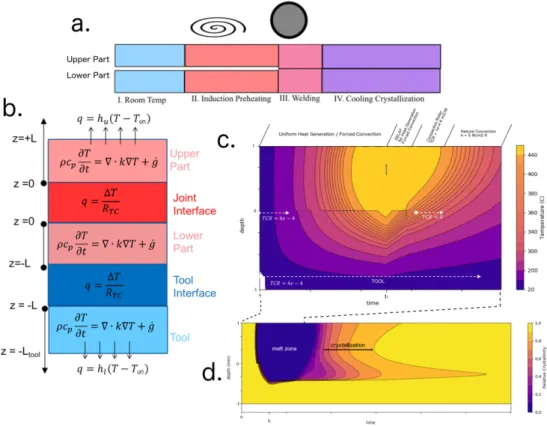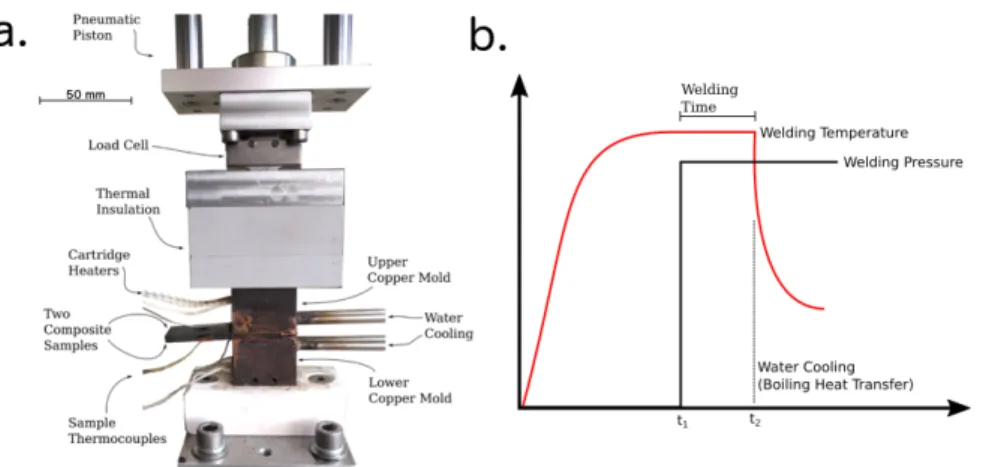HAL Id: hal-02375923
https://hal.archives-ouvertes.fr/hal-02375923
Submitted on 8 Apr 2021HAL is a multi-disciplinary open access archive for the deposit and dissemination of sci-entific research documents, whether they are pub-lished or not. The documents may come from teaching and research institutions in France or abroad, or from public or private research centers.
L’archive ouverte pluridisciplinaire HAL, est destinée au dépôt et à la diffusion de documents scientifiques de niveau recherche, publiés ou non, émanant des établissements d’enseignement et de recherche français ou étrangers, des laboratoires publics ou privés.
Continuous Fusion Bonding of High Temperature
Thermoplastic Composite Structures withVolumetric
Heating
Tom Cender, Arthur Lévy, Steven Le Corre
To cite this version:
Tom Cender, Arthur Lévy, Steven Le Corre. Continuous Fusion Bonding of High Temperature Ther-moplastic Composite Structures withVolumetric Heating. ICMAC 2018 - 11th International Con-ference on Manufacturing of Advanced Composites, Jul 2018, Nottingham, United Kingdom. �hal-02375923�
Continuous Fusion Bonding of High Temperature
Thermoplastic Composite Structures with Volumetric Heating
Thomas A. Cender1,2, Arthur Levy1, Steven Le Corre1
1Laboratoire de Thermique et Energie de Nantes, Université de Nantes, Nantes, France 2IRT Jules Verne, Bouguenais, France
Corresponding Email Address: arthur.levy@univ-nantes.fr
ICMAC 2018 - 11th International Conference on Manufacturing of Advanced Composites Nottingham, England, 11-12 July, 2018
1. Introduction
Composite materials (fiber reinforced plastics) continue to replace metallic structures in aerospace applications in order to realize the benefit of their high specific stiffness and strength. Forming processes often attempt to produce continuous monolithic structures since fiber reinforced composites are more prone to structural weaknesses when traditional fasteners are used. Even so, joining structures is always necessity. When choosing thermoplastics instead of thermosetting polymers, the ability to melt and reform the polymer can be leveraged into a process to weld/join parts by heating and pressing together an interface. At elevated temperatures, the thermoplastic polymer interface can heal over time via auto-adhesion, producing a seamless structure. In this study, we explore the scenario where, an induction head is used to induce an electrical current in the carbon fiber reinforcement, which in turn produces a volumetric heat generation through the part thickness.
With the primary goal of the process being polymer auto-adhesion at the interface of the two structures, the conditions for adhesion time (as a function of temperature) are determined experimentally and the remaining process conditions are optimized. The tradeoff between welding temperature and welding time is evaluated by how other aspects of the material are effected. A process model is introduced to predict and control material transformation: melting, degradation, crystallization, and interface healing. A parametric study of the process inputs, (the heat generation density and pattern, the welding head speed, and heat loss from convection) reveals the processing limitations in achieving optimal structural quality.
2. Heat Transfer Process Model
The polymer of interest for this case study is thermoplastic PEKK (PolyEtherKetoneKetone). Owing to its high glass transition temperature, melt processing must be performed at temperatures in excess of 350°C [2]. Via an induction coil [3-4], the carbon fibers are heated to reach the processing temperature within seconds. Heat is removed from part by conduction into the tooling and forced air convection. Figure 1 shows (a) the configuration of the process, (b) a schematic of the through-thickness heat transfer model, (c) temperature distribution in the material (from the model) as the material passes through the series of process phases, and (d) the crystallinity of the material as it melts and recrystallizes.
Figure 1. a) A schematic showing the process. An induction coil heats the composite before a compaction roller. The roller consolidates and welds the two parts. b) A 1D through-thickness heat transfer model to predict the temperature field and material transformation. c) The temperature through the domain as the sample passes under an induction heater followed by a compaction roller. d) Following the compaction roller, the material required to cool slowly to allow the polymer to crystallize.
3. Auto-adhesion Characterization
Previous studies on similar materials have shown that full adhesion will take on the order of tens of minutes [2,5]. In this study, we are most interested in the adhesion at short time scales which is still a big challenge. First attempts on a GF/PA66 woven composite were already presented in [6], showing the feasibility of such an experimental approach.
3.1 Rheological tests
To study the process of auto adhesion, rheological tests and welding tests are performed in concert. The temperature dependence of the rheological properties was determined by performing a series of isothermal small angle oscillatory shear tests. By performing a Time-Temperature-Superposition, the thermal activation energy of the polymer is evaluated, as well as the relaxation time.
3.2 Lab scale welding bench
Concurrently, a benchtop sample welding apparatus is used to weld coupons at constant temperature and pressure, for a finite amount of time [6]. As shown in Figure 2a., the device consists of an upper and lower temperature controlled copper block, with an internal thermocouple near the sample surface and cartridge heaters. Additionally, the copper blocks have internal plumbing to introduce cooling water—which rapidly cools the sample. The upper fixture is attached in series to an insulating material, a load cell, and a pneumatic piston. Composite samples are adhered to the upper and lower copper blocks. At the beginning of each test, the two composite samples are separated. Once the samples are isothermal at the desired temperature, the piston presses the samples together, beginning the welding process. To seize the auto adhesion process, cooling water is introduced to quench the copper blocks. Several
tests (where the auto-adhesion process in interrupted at different points in time) are performed to to determine the effect of temperature and time on the welding process.
3.3 Adhesion test
Once the samples were welded, a double cantilever beam test is used to determine the quality of the weld. As the weld time is successively increased, the critical strain energy release rate (G1c) reaches a plateau. Values of G1c measured below this plateau are considered partially welded.
Figure 2. a) The test fixture for welding two composite samples at isothermal conditions. b) The test cycle involves heating the sample to a desired temperature, compressing the samples together, followed by a rapid cooling to halt the auto-adhesion process.
4. Expected Results
The advantage of this approach is that it correlates the mechanical quality of adhesion (degree of adhesion) directly to the temperature history of the interface. A comparison with the rheological results will determine whether this auto-adhesion dependence on temperature follow the same Arrhenius law as that of the rheological relaxation times. It is expected that a correction is needed to relate the polymer relaxation time and the sample auto-adhesion time.
Acknowledgements
This work is part of the SIDEFFECT project managed by IRT Jules Verne (French Institute for Research and Technology in Advanced Manufacturing Technologies for Composite, Metallic and Hybrid Structures). The authors wish to associate the industrial and academic partners of this project; respectively Stelia Aerospace, Airbus, Europe Technologies, Hutchinson, Cetim, Aviacomp, and IREENA Université de Nantes. Special thanks to Florian Tellier and Pierre Couarraze of IRT Jules Verne, and Damien Sireude of Stelia Aerospace for their involvement in this work.
References
1. A. Yousefpour, M Hojiati, and J-P Immarigeon “Fusion Bonding/Welding of Thermoplastic Composites” J. Themoplastic Comp. Mat. 2004, 17, 303-341.
2. F. Yang and R. Pitchumani “Healing of Thermoplastic Polymers at an Interface Under Non-isothermal Conditions” Macromolecules 2002, 35, 3213-3224.
3. P. Mitschang, R. Rudolf, and M. Neitzel “Continuous Induction Welding Process, Modelling and Realization” J. Themoplastic Comp. Mat. 2002, 15, 127-153.
4. Wasselynck, G., Trichet, D., & Fouladgar, J. Determination of the electrical conductivity tensor of a CFRP composite using a 3-D percolation model. IEEE Transactions on Magnetics, 29013, 49(5), 1825–1828.
5. W.I. Lee and G.S. Springer “A Model of the Manufacturing Process of Thermoplastic Matrix Composites” J. Comp. Mat., 1987. 21(11), 1017–1055.
6. A. Harkous, T. Jurkowski, J-L Bailleul, and S. Le Corre, “Influence of the temperature on the composites’ fusion bonding quality” AIP Conf. Proc. April 2017

